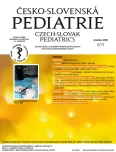-
Medical journals
- Career
Laparoscopy in childhood – appendectomy, spleen preserving surgery, hepatobiliary surgery
Authors: J. Babala; R. Pechanová; P. Zahradnikova; I. Béder
Authors‘ workplace: Klinika detskej chirurgie LFUK a Núdch, Bratislava
Published in: Čes-slov Pediat 2018; 73 (8): 480-485.
Category:
Overview
Objective:
The aim of this article is to inform about certain existing laparoscopic procedures in children and to focus on the benefit as well as eventual challenges and limitations especially in very small children.
Methods:
We have evaluated laparoscopic surgeries similar to those in adults that are performed more frequently and are more available: appendectomy and cholecystectomy and specific less frequent surgeries based on the congenital developmental defects: biliary atresia and choledochal cysts. The spleen-preserving resection describes the preservation of an organ by using an innovative method.
Results:
The results indicate that it is easier to make recommendations for surgical procedures performed more frequently (531 patients with appendectomy and 75 patients with cholecystectomy) and sometimes there are no clear-cut indication criteria for surgical procedures performed less frequently despite the summary of multicentre studies (22 patients having surgery for the suspected biliary atresia and 4 patients having surgery for the cystic malformation of the bile duct).
Conclusion:
Minimally invasive surgical procedures in the smallest children exclusive due to their low frequency require centralization and multidisciplinary collaboration. The literary data indicate that it will not be easy to make the general guidelines for the selected surgical procedure.
KEY WORDS:
laparoscopy in childhood, appendectomy, cholecystectomy, spleen sparing surgery, hepatobiliary surgery
Sources
1. Holcomb III GW. Principles of laparoscopic surgery. In: Holcomb III GW, Georgeson KE, Rothenberg SS. Atlas of Pediatric Laparoscopy and Thoracoscopy. Philadelphia: Saunders Elseviers, 2008.
2. Blinman T, Ponsky T. Pediatric minimally invasive surgery: Laparoscopy and thoracoscopy in infants and children. Pediatrics 2012; 130 (3): 539–549.
3. Madadi-Sanjani O, Petersen C, Ure B. Minimally invasive hepatobiliary surgery. In: Minimally Invasive Neonatal Surgery 2017; 44 (4): 805–818. An Issue of Clinics in Perinatology, E-Book.
4. Starý D, Tůma J, Doušek R, et al. Laparoskopie na pracovišti dětské chirurgie v pětiletém období. Rozhl Chir 2018; 97 (3): 128–132.
5. Rygl M. Dětská chirurgie ve 21. století. Rozhl Chir 2018; 97 (3): 103–104.
6. Morinis J, Dutta S, Blanchette V, et al. Laparoscopic partial vs total splenectomy in children with hereditary spherocytosis. J Pediatr Surg 2008; 43 (9): 1649–1652.
7. Kaiwa Y, Kurokawa Y, Namiki K, et al. Laparoscopic partial splenectomies for true splenic cysts. A report of two cases. Surg Endosc 2000; 14 (9): 865.
8. Till H, Schaarschmidt K. Partial laparoscopic decapsulation of congenital splenic cysts: a medium-term evaluation proves the efficiency in children. Surgical Endoscopy & Interventional Techniques 2004; 18 (4): 626–628.
9. Wang X1, Wang M, Zhang H, Peng B. Laparoscopic partial splenectomy is safe and effective in patients with focal benign splenic lesion. Surg Endosc 2014; 28 (12): 3273–3278.
10. Heri G, Becmeur F, Méfat L, et al. Laparoscopic Partial Splenectomy: Indications and results of a multicenter retrospective study. Surg Endosc 2008; 22 (1): 45–49.
11. Vasilescu C, Tudor S, Popa M, et al. Robotic partial splenectomy for hydatid cyst of the spleen. Langenbeck´s Arch Surg 2010; 395 (8): 1169–1174.
12. Weng R, Hu W, Cai S,et al. Prenatal diagnosis and prognosis assessment of congenital choledochal cystin 21 cases. J Obstet Gynaecol 2016; 36 (3): 324–327.
13. Ohashi T, Wakai T, Kubota M, et al. Risk of subsequent biliary malignancy in patients undergoing cyst excision for congenital choledochal cysts. J Gastroenterol Hepatol 2013; 28 (2): 243–247.
14. Zhen C, Xia Z, Long L, et al. Laparoscopic excision versus open excision for the treatment of choledochal cysts: a systemic review and meta-analysis. Int Surg 2015; 100 (1): 115–122.
15. Davenport M, Ong E, Sharif K, et al. Biliary atresia in England and Wales: results of centralization and new benchmark. J Pediatr Surg 2011; 46 (9): 1689–1694.
16. Kishore R, Kisku SMC, Thomas RJ, Jeenipalli SK. Laparoscopic cholangiogram in biliary atresia: a refinement in the gallbladder hitch technique. Pediatr Surg Int 2018; 34 (4): 395–398.
17. LishuangM, Zhen C, Guoliang Q, et al. Laparoscopic portoenterostomy versus open portoenterostomy for the treatment of biliary atresia: a systemic review and meta-analysis of comparative studies. Pediatr Surg Int 2015; 31 (3): 261–269.
18. Halata MS, Berezin SH. Biliary dyskinesia in the pediatric patient. Curr Gastroenterol Rep 2008; 10 (3): 332–338.
19. Al Talhi Y, Shirah BH, et al. Laparoscopic cholecystectomy for cholelithiasis in children with sickle cell disease. Clin J Gastroenterol 2017; 10 (4): 320–326.
20. Zitsman JL. Current concepts in minimal access surgery for children. Pediatrics 2003; 111 (6): 1239–1252.
Labels
Neonatology Paediatrics General practitioner for children and adolescents
Article was published inCzech-Slovak Pediatrics

2018 Issue 8-
All articles in this issue
- Focal nodular hyperplasia in children – diagnostics and treatment
- Bone remodeling – the basic condition for treatment of forearm fractures in the growing skeleton
- Laparoscopy in childhood – appendectomy, spleen preserving surgery, hepatobiliary surgery
- Necrotizing enterocolitis in the Perinatological Centre of the University Hospital Hradec Králové in 2010–2017
- The Family Eating and Activity Habits Questionnaire – Czech translation and verification questionnaire clarity
- The current incidence of coronary heart disease risk factors in children in the Czech Republic in 2016
- Czech-Slovak Pediatrics
- Journal archive
- Current issue
- Online only
- About the journal
Most read in this issue- Focal nodular hyperplasia in children – diagnostics and treatment
- Necrotizing enterocolitis in the Perinatological Centre of the University Hospital Hradec Králové in 2010–2017
- Bone remodeling – the basic condition for treatment of forearm fractures in the growing skeleton
- The current incidence of coronary heart disease risk factors in children in the Czech Republic in 2016
Login#ADS_BOTTOM_SCRIPTS#Forgotten passwordEnter the email address that you registered with. We will send you instructions on how to set a new password.
- Career

